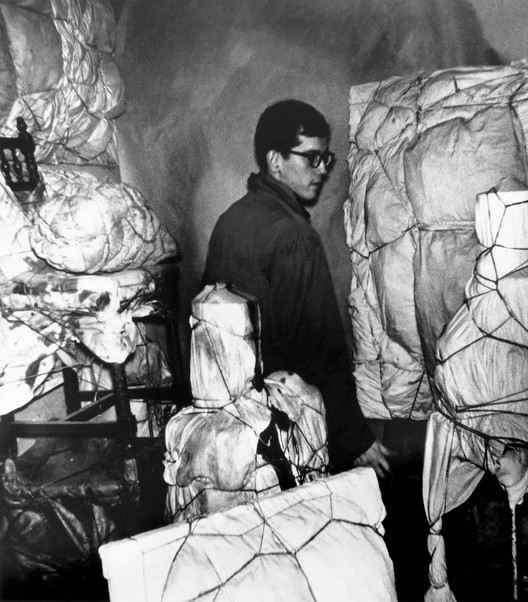
Gagosian Gallery Paris has announced an exhibition dedicated to Christo, presented in collaboration with the artist’s estate. Featuring sculptures made in Paris between 1958 and 1963, the exhibition features the earliest examples of Christo’s wrapped objects and barrel structures, many of which are exhibited for the first time, along with key works from his rarely shown Surfaces d’Empaquetage and Cratères series. The exhibition is open to the public on June 10, displayed across two floors of Gagosian’s rue de Ponthieu gallery, near Christo’s first Paris studio.
Christo moved to Paris in 1958, founding a studio in a small maid’s room at 14 rue de Saint Sénoch in the 17th arrondissement. During that time, he created his first Wrapped Objects and barrel structures, which then became prominent features of his practice. The artist found inspiration from connections with leading figures of the European and American avant-garde, including Joseph Beuys, John Cage, Nam June Paik, Pierre Restany, and Karlheinz Stockhausen. That same year, he met Jeanne-Claude Denat de Guillebon, who became his wife and creative partner, co-creating monumental works of art that changed the way people perceive public art.

The tactile works of the Surfaces d’Empaquetage (1958–61) series are created with crumpled fabric or paper, coated with thin layers of lacquer and sand. In 1959, after visiting an exhibition that included work by Jean Dubuffet, Christo embarked on another series, Cratères. Thick, coagulated layers of dark brown paint characterizing these wall-mounted panels revealed his growing interest in three-dimensional mediums. In some, he attached empty paint cans to the base before applying a mixture of sand, enamel, and glue, creating a mesh of furrows, and trenches, that penetrate the space.
Christo was first intrigued by steel oil drums for their scale, economical price, and indestructibility, which he began to cover with the same fabric, varnish, paint, and sand that he used on smaller objects like cans and bottles. The larger dimensions of the barrels and their arrangements into groups gave them a monumental character, influencing Christo to expand the scale of his environmental works.

Most of Christo’s first Wrapped Objects sculptures incorporate conventional art materials such as paint cans and pigment bottles, covered in a resin-soaked canvas. Enveloping everyday objects with fabric or polyethylene sheets and binding them with rope altered their silhouettes and surfaces, playing with their identities. The series lasted for more than sixty years, informing more complex interventions, leading to the massive 2021 project L’Arc de Triomphe, Wrapped, which he first proposed in 1961.

I started working on the Cratères, the Wrapped Cans, the Surfaces d’Empaquetage around the same time, in 1958. In the beginning, the wrapping was not essential. It was not so much about making an object, but more about the texture of the object itself. I used fabric to wrap the cans, then I applied paint and lacquer to stiffen the fabric. This way they became like a still life. -- Christo

The exhibition comes after an early interest in Christo, when the founder of the gallery presented an exhibition of Jeanne-Claude and his work Running Fence in Los Angeles in the mid-’70s.













